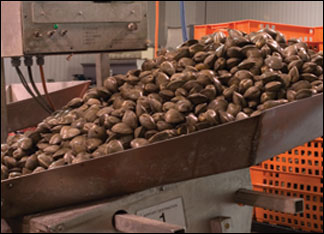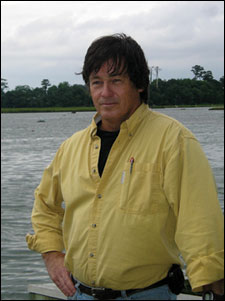By Erica Goldman

Clam culture is a lucrative business at Cherrystone Aqua-Farm (above) on Virginia's Eastern Shore. Could bivalve culture bring another payoff by helping to reduce nutrients in the Bay? Biologist Mark Luckenbach (right) and his colleagues at the Virginia Institute of Marine Science are trying to find out. Photographs by Erica Goldman (above) and Jack Greer (right). |
|

|
Acre per acre, the most valuable farmland in Virginia is underwater. On the distant reach of Virginia's Eastern Shore, Cherrystone Creek hosts some 100 million hard clams, worth $65,000 per acre per year.
"There are no other legal crops in the U.S. that yield that much per acre," says Mark Luckenbach, a biologist at the Eastern Shore Laboratory of the Virginia Institute of Marine Science (VIMS).
Cherrystone Creek serves as a grow-out area for Cherrystone Aqua-Farms, a commercial-scale clam hatchery in Cheriton, Virginia. Of their own accord, these bivalves would never live so densely packed in such a small underwater area. And Luckenbach wanted to know whether this city of clams packs a measurable impact on water clarity in the creek.
On the surface, the changes seem dramatic, says Luckenbach. "You can walk through Cherrystone Creek in waist-deep water and see your toes in the middle of summer," he says. "Many people will say, ‘water here hasn't been this clear since my granddaddy lived here.'" Can clams claim credit for removing a significant amount of the phytoplankton?
Luckenbach and his colleagues at VIMS, including researchers Harry Wang and Jian Shen, set out to scientifically validate what they were seeing in Cherrystone Creek. The team started with a water quality model that Wang's group had shown to accurately simulate the dynamics of algae abundance (primary production) in other parts of the Bay. Once they put the necessary stats on Cherrystone Creek into the model, the team compared algae abundance predicted by the computer model to amounts actually measured in the creek. They found that the model overestimated the amount of phytoplankton present. The waters were clearer than expected.
Adding in mathematical terms to simulate the effect of clams feeding in Cherrystone Creek, the team ran the water quality model again. Now it accurately predicted the amount of phytoplankton actually measured in the creek.
"No question that the clams are removing a significant amount of the phytoplankton," says Luckenbach.
So why isn't clam aquaculture a logical answer to the Bay's water quality woes? Couldn't this economic powerhouse of an industry also prove an ecological benefit to the Chesapeake's creeks and rivers?
It's not that simple, says Luckenbach. Like any confined animal farming operation, aquaculture changes the dynamics in an ecosystem.
The caged clams take up chlorophyll and nutrients, but they also excrete a lot of nitrogen — in the form of ammonia, he explains. Since the clams are densely packed, that nitrogen is highly concentrated, acting as a ready food source for seaweed (macroalgae). In addition, predator-exclusion nets cover the clam beds to protect them from rays and other predators. Those nets further accelerate the growth of seaweed, providing an inviting surface on which to grow.
So the waters of Cherrystone Creek might now be clear, but have overall conditions improved? "Your answer might be different if you had just walked down to your beach the day before and found it piled shin-high with rotting seaweed," says Luckenbach. Aquaculturists intermittently scrape the algae off the clam beds to maintain the flow of fresh water over the clams. "Unchecked, this algae can wash onto beaches where it can rot and stink," he says.
But macroalgae may also offer an unexpected opportunity to reduce nutrient pollution in the Bay. Scientists suspect macroalgae locks up (sequesters) a lot of nitrogen. Since excess nitrogen is generally regarded as the most significant pollutant in the Chesapeake, Luckenbach wondered if simply removing algae from clam nets would decrease nitrogen loads to the Bay, helping to further improve water quality. Could clam farmers, then, harvest macroalgae in addition to their clams and remove even more nutrients from the Bay?
To explore this question, Luckenbach recently launched an effort to determine exactly how much nitrogen and phosphorus are locked up in macroalgae. He's undertaking the study in partnership with Cherrystone Aqua-Farm President Mike Pierson and Jonathan Davis from Taylor Shellfish in Seattle, Washington. Although the nutrient analysis has not been completed, the sheer quantity of algae associated with the aquaculture clam beds is quite impressive, says Luckenbach. During May of this year the team estimates that over 150,000 pounds (wet weight) of algae grew attached to the nets on a single clam farm in Cherrystone Creek.
If reducing nitrogen loads in Chesapeake Bay could be accomplished by removing algae from clam nets, what stands in the way? It comes down to economics, explains Luckenbach. In some areas aquaculturists do collect algae and remove it from the creek, but this is a costly activity, one for which clam culturists currently receive no economic returns. Luckenbach suggests that establishing incentives might help solidify an algae-removal practice among clam culturists. He identifies two different market-based approaches that might simultaneously serve the dual goals of commercial growth and ecosystem restoration. One would involve creating a market for fertilizer made from seaweed, thereby providing an economic reason for aquaculturists to truck this macroalgae (and therefore nitrogen) away from the Chesapeake Bay. The other would involve a nutrient trading program, where aquaculturists who did remove macroalgae from the system could earn some sort of nutrient-removal credit. These credits could then be sold for money to other businesses that might be over their pre-determined nutrient load limit.
Aquaculture programs that link ecosystem services to the economic bottom line are still a ways off. At this point, says Luckenbach, we need to better understand what having these agroecosystems in our landscape means to our ecology. "They might be good, they might be bad, but they are not going away."
![[Maryland Sea Grant]](/GIFs/h_footer_mdsg.gif)